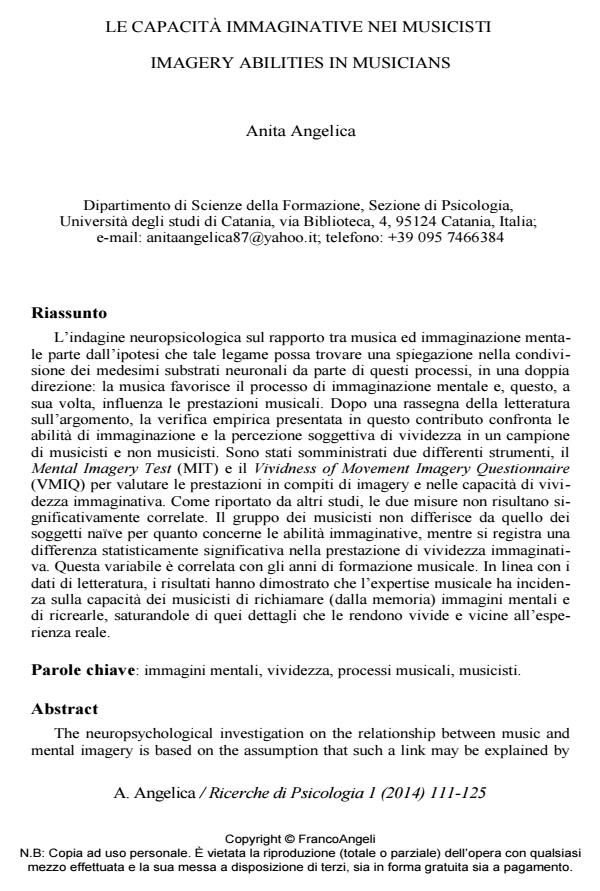Le capacità immaginative nei musicisti
Titolo Rivista RICERCHE DI PSICOLOGIA
Autori/Curatori Anita Angelica
Anno di pubblicazione 2014 Fascicolo 2014/1
Lingua Italiano Numero pagine 15 P. 111-125 Dimensione file 193 KB
DOI 10.3280/RIP2014-001006
Il DOI è il codice a barre della proprietà intellettuale: per saperne di più
clicca qui
Qui sotto puoi vedere in anteprima la prima pagina di questo articolo.
Se questo articolo ti interessa, lo puoi acquistare (e scaricare in formato pdf) seguendo le facili indicazioni per acquistare il download credit. Acquista Download Credits per scaricare questo Articolo in formato PDF

FrancoAngeli è membro della Publishers International Linking Association, Inc (PILA)associazione indipendente e non profit per facilitare (attraverso i servizi tecnologici implementati da CrossRef.org) l’accesso degli studiosi ai contenuti digitali nelle pubblicazioni professionali e scientifiche
L’indagine neuropsicologica sul rapporto tra musica ed immaginazione mentale parte dall’ipotesi che tale legame possa trovare una spiegazione nella condivisione dei medesimi substrati neuronali da parte di questi processi, in una doppia direzione: la musica favorisce il processo di immaginazione mentale e, questo, a sua volta, influenza le prestazioni musicali. Dopo una rassegna della letteratura sull’argomento, la verifica empirica presentata in questo contributo confronta le abilita di immaginazione e la percezione soggettiva di vividezza in un campione di musicisti e non musicisti. Sono stati somministrati due differenti strumenti, il Mental Imagery Test (MIT) e il Vividness of Movement Imagery Questionnaire (VMIQ) per valutare le prestazioni in compiti di imagery e nelle capacita di vividezza immaginativa. Come riportato da altri studi, le due misure non risultano significativamente correlate. Il gruppo dei musicisti non differisce da quello dei soggetti naive per quanto concerne le abilita immaginative, mentre si registra una differenza statisticamente significativa nella prestazione di vividezza immaginativa. Questa variabile e correlata con gli anni di formazione musicale. In linea con i dati di letteratura, i risultati hanno dimostrato che l’expertise musicale ha incidenza sulla capacita dei musicisti di richiamare (dalla memoria) immagini mentali e di ricrearle, saturandole di quei dettagli che le rendono vivide e vicine all’esperienza reale.
Parole chiave:Immagini mentali, vividezza, processi musicali, musicisti.
Anita Angelica, Le capacità immaginative nei musicisti in "RICERCHE DI PSICOLOGIA " 1/2014, pp 111-125, DOI: 10.3280/RIP2014-001006